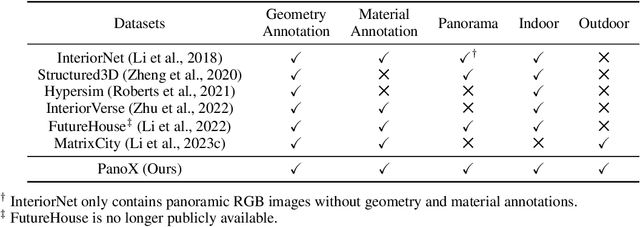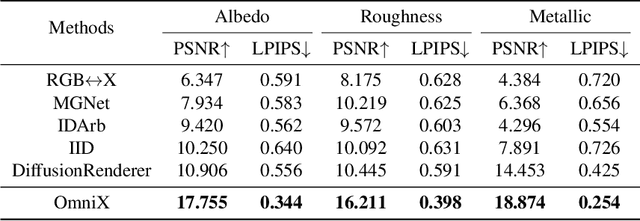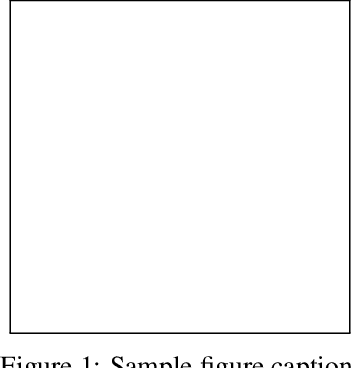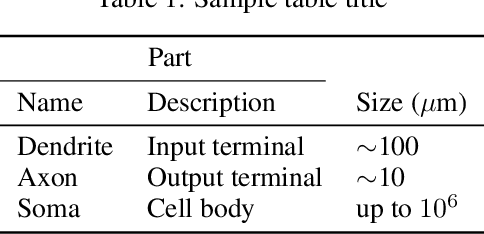Xintao Wang
OmniX: From Unified Panoramic Generation and Perception to Graphics-Ready 3D Scenes
Oct 30, 2025



Abstract:There are two prevalent ways to constructing 3D scenes: procedural generation and 2D lifting. Among them, panorama-based 2D lifting has emerged as a promising technique, leveraging powerful 2D generative priors to produce immersive, realistic, and diverse 3D environments. In this work, we advance this technique to generate graphics-ready 3D scenes suitable for physically based rendering (PBR), relighting, and simulation. Our key insight is to repurpose 2D generative models for panoramic perception of geometry, textures, and PBR materials. Unlike existing 2D lifting approaches that emphasize appearance generation and ignore the perception of intrinsic properties, we present OmniX, a versatile and unified framework. Based on a lightweight and efficient cross-modal adapter structure, OmniX reuses 2D generative priors for a broad range of panoramic vision tasks, including panoramic perception, generation, and completion. Furthermore, we construct a large-scale synthetic panorama dataset containing high-quality multimodal panoramas from diverse indoor and outdoor scenes. Extensive experiments demonstrate the effectiveness of our model in panoramic visual perception and graphics-ready 3D scene generation, opening new possibilities for immersive and physically realistic virtual world generation.
VFXMaster: Unlocking Dynamic Visual Effect Generation via In-Context Learning
Oct 29, 2025Abstract:Visual effects (VFX) are crucial to the expressive power of digital media, yet their creation remains a major challenge for generative AI. Prevailing methods often rely on the one-LoRA-per-effect paradigm, which is resource-intensive and fundamentally incapable of generalizing to unseen effects, thus limiting scalability and creation. To address this challenge, we introduce VFXMaster, the first unified, reference-based framework for VFX video generation. It recasts effect generation as an in-context learning task, enabling it to reproduce diverse dynamic effects from a reference video onto target content. In addition, it demonstrates remarkable generalization to unseen effect categories. Specifically, we design an in-context conditioning strategy that prompts the model with a reference example. An in-context attention mask is designed to precisely decouple and inject the essential effect attributes, allowing a single unified model to master the effect imitation without information leakage. In addition, we propose an efficient one-shot effect adaptation mechanism to boost generalization capability on tough unseen effects from a single user-provided video rapidly. Extensive experiments demonstrate that our method effectively imitates various categories of effect information and exhibits outstanding generalization to out-of-domain effects. To foster future research, we will release our code, models, and a comprehensive dataset to the community.
GRPO-Guard: Mitigating Implicit Over-Optimization in Flow Matching via Regulated Clipping
Oct 25, 2025Abstract:Recently, GRPO-based reinforcement learning has shown remarkable progress in optimizing flow-matching models, effectively improving their alignment with task-specific rewards. Within these frameworks, the policy update relies on importance-ratio clipping to constrain overconfident positive and negative gradients. However, in practice, we observe a systematic shift in the importance-ratio distribution-its mean falls below 1 and its variance differs substantially across timesteps. This left-shifted and inconsistent distribution prevents positive-advantage samples from entering the clipped region, causing the mechanism to fail in constraining overconfident positive updates. As a result, the policy model inevitably enters an implicit over-optimization stage-while the proxy reward continues to increase, essential metrics such as image quality and text-prompt alignment deteriorate sharply, ultimately making the learned policy impractical for real-world use. To address this issue, we introduce GRPO-Guard, a simple yet effective enhancement to existing GRPO frameworks. Our method incorporates ratio normalization, which restores a balanced and step-consistent importance ratio, ensuring that PPO clipping properly constrains harmful updates across denoising timesteps. In addition, a gradient reweighting strategy equalizes policy gradients over noise conditions, preventing excessive updates from particular timestep regions. Together, these designs act as a regulated clipping mechanism, stabilizing optimization and substantially mitigating implicit over-optimization without relying on heavy KL regularization. Extensive experiments on multiple diffusion backbones (e.g., SD3.5M, Flux.1-dev) and diverse proxy tasks demonstrate that GRPO-Guard significantly reduces over-optimization while maintaining or even improving generation quality.
Harnessing Uncertainty: Entropy-Modulated Policy Gradients for Long-Horizon LLM Agents
Sep 11, 2025Abstract:In long-horizon tasks, recent agents based on Large Language Models (LLMs) face a significant challenge that sparse, outcome-based rewards make it difficult to assign credit to intermediate steps. Previous methods mainly focus on creating dense reward signals to guide learning, either through traditional reinforcement learning techniques like inverse reinforcement learning or by using Process Reward Models for step-by-step feedback. In this paper, we identify a fundamental problem in the learning dynamics of LLMs: the magnitude of policy gradients is inherently coupled with the entropy, which leads to inefficient small updates for confident correct actions and potentially destabilizes large updates for uncertain ones. To resolve this, we propose Entropy-Modulated Policy Gradients (EMPG), a framework that re-calibrates the learning signal based on step-wise uncertainty and the final task outcome. EMPG amplifies updates for confident correct actions, penalizes confident errors, and attenuates updates from uncertain steps to stabilize exploration. We further introduce a bonus term for future clarity that encourages agents to find more predictable solution paths. Through comprehensive experiments on three challenging agent tasks, WebShop, ALFWorld, and Deep Search, we demonstrate that EMPG achieves substantial performance gains and significantly outperforms strong policy gradient baselines. Project page is at https://empgseed-seed.github.io/
Curse of Knowledge: When Complex Evaluation Context Benefits yet Biases LLM Judges
Sep 03, 2025Abstract:As large language models (LLMs) grow more capable, they face increasingly diverse and complex tasks, making reliable evaluation challenging. The paradigm of LLMs as judges has emerged as a scalable solution, yet prior work primarily focuses on simple settings. Their reliability in complex tasks--where multi-faceted rubrics, unstructured reference answers, and nuanced criteria are critical--remains understudied. In this paper, we constructed ComplexEval, a challenge benchmark designed to systematically expose and quantify Auxiliary Information Induced Biases. We systematically investigated and validated 6 previously unexplored biases across 12 basic and 3 advanced scenarios. Key findings reveal: (1) all evaluated models exhibit significant susceptibility to these biases, with bias magnitude scaling with task complexity; (2) notably, Large Reasoning Models (LRMs) show paradoxical vulnerability. Our in-depth analysis offers crucial insights for improving the accuracy and verifiability of evaluation signals, paving the way for more general and robust evaluation models.
SimpleGVR: A Simple Baseline for Latent-Cascaded Video Super-Resolution
Jun 24, 2025Abstract:Latent diffusion models have emerged as a leading paradigm for efficient video generation. However, as user expectations shift toward higher-resolution outputs, relying solely on latent computation becomes inadequate. A promising approach involves decoupling the process into two stages: semantic content generation and detail synthesis. The former employs a computationally intensive base model at lower resolutions, while the latter leverages a lightweight cascaded video super-resolution (VSR) model to achieve high-resolution output. In this work, we focus on studying key design principles for latter cascaded VSR models, which are underexplored currently. First, we propose two degradation strategies to generate training pairs that better mimic the output characteristics of the base model, ensuring alignment between the VSR model and its upstream generator. Second, we provide critical insights into VSR model behavior through systematic analysis of (1) timestep sampling strategies, (2) noise augmentation effects on low-resolution (LR) inputs. These findings directly inform our architectural and training innovations. Finally, we introduce interleaving temporal unit and sparse local attention to achieve efficient training and inference, drastically reducing computational overhead. Extensive experiments demonstrate the superiority of our framework over existing methods, with ablation studies confirming the efficacy of each design choice. Our work establishes a simple yet effective baseline for cascaded video super-resolution generation, offering practical insights to guide future advancements in efficient cascaded synthesis systems.
FilMaster: Bridging Cinematic Principles and Generative AI for Automated Film Generation
Jun 23, 2025Abstract:AI-driven content creation has shown potential in film production. However, existing film generation systems struggle to implement cinematic principles and thus fail to generate professional-quality films, particularly lacking diverse camera language and cinematic rhythm. This results in templated visuals and unengaging narratives. To address this, we introduce FilMaster, an end-to-end AI system that integrates real-world cinematic principles for professional-grade film generation, yielding editable, industry-standard outputs. FilMaster is built on two key principles: (1) learning cinematography from extensive real-world film data and (2) emulating professional, audience-centric post-production workflows. Inspired by these principles, FilMaster incorporates two stages: a Reference-Guided Generation Stage which transforms user input to video clips, and a Generative Post-Production Stage which transforms raw footage into audiovisual outputs by orchestrating visual and auditory elements for cinematic rhythm. Our generation stage highlights a Multi-shot Synergized RAG Camera Language Design module to guide the AI in generating professional camera language by retrieving reference clips from a vast corpus of 440,000 film clips. Our post-production stage emulates professional workflows by designing an Audience-Centric Cinematic Rhythm Control module, including Rough Cut and Fine Cut processes informed by simulated audience feedback, for effective integration of audiovisual elements to achieve engaging content. The system is empowered by generative AI models like (M)LLMs and video generation models. Furthermore, we introduce FilmEval, a comprehensive benchmark for evaluating AI-generated films. Extensive experiments show FilMaster's superior performance in camera language design and cinematic rhythm control, advancing generative AI in professional filmmaking.
FullDiT2: Efficient In-Context Conditioning for Video Diffusion Transformers
Jun 05, 2025Abstract:Fine-grained and efficient controllability on video diffusion transformers has raised increasing desires for the applicability. Recently, In-context Conditioning emerged as a powerful paradigm for unified conditional video generation, which enables diverse controls by concatenating varying context conditioning signals with noisy video latents into a long unified token sequence and jointly processing them via full-attention, e.g., FullDiT. Despite their effectiveness, these methods face quadratic computation overhead as task complexity increases, hindering practical deployment. In this paper, we study the efficiency bottleneck neglected in original in-context conditioning video generation framework. We begin with systematic analysis to identify two key sources of the computation inefficiencies: the inherent redundancy within context condition tokens and the computational redundancy in context-latent interactions throughout the diffusion process. Based on these insights, we propose FullDiT2, an efficient in-context conditioning framework for general controllability in both video generation and editing tasks, which innovates from two key perspectives. Firstly, to address the token redundancy, FullDiT2 leverages a dynamic token selection mechanism to adaptively identify important context tokens, reducing the sequence length for unified full-attention. Additionally, a selective context caching mechanism is devised to minimize redundant interactions between condition tokens and video latents. Extensive experiments on six diverse conditional video editing and generation tasks demonstrate that FullDiT2 achieves significant computation reduction and 2-3 times speedup in averaged time cost per diffusion step, with minimal degradation or even higher performance in video generation quality. The project page is at \href{https://fulldit2.github.io/}{https://fulldit2.github.io/}.
UNIC: Unified In-Context Video Editing
Jun 04, 2025

Abstract:Recent advances in text-to-video generation have sparked interest in generative video editing tasks. Previous methods often rely on task-specific architectures (e.g., additional adapter modules) or dedicated customizations (e.g., DDIM inversion), which limit the integration of versatile editing conditions and the unification of various editing tasks. In this paper, we introduce UNified In-Context Video Editing (UNIC), a simple yet effective framework that unifies diverse video editing tasks within a single model in an in-context manner. To achieve this unification, we represent the inputs of various video editing tasks as three types of tokens: the source video tokens, the noisy video latent, and the multi-modal conditioning tokens that vary according to the specific editing task. Based on this formulation, our key insight is to integrate these three types into a single consecutive token sequence and jointly model them using the native attention operations of DiT, thereby eliminating the need for task-specific adapter designs. Nevertheless, direct task unification under this framework is challenging, leading to severe token collisions and task confusion due to the varying video lengths and diverse condition modalities across tasks. To address these, we introduce task-aware RoPE to facilitate consistent temporal positional encoding, and condition bias that enables the model to clearly differentiate different editing tasks. This allows our approach to adaptively perform different video editing tasks by referring the source video and varying condition tokens "in context", and support flexible task composition. To validate our method, we construct a unified video editing benchmark containing six representative video editing tasks. Results demonstrate that our unified approach achieves superior performance on each task and exhibits emergent task composition abilities.
Can LLMs Learn to Map the World from Local Descriptions?
May 27, 2025Abstract:Recent advances in Large Language Models (LLMs) have demonstrated strong capabilities in tasks such as code and mathematics. However, their potential to internalize structured spatial knowledge remains underexplored. This study investigates whether LLMs, grounded in locally relative human observations, can construct coherent global spatial cognition by integrating fragmented relational descriptions. We focus on two core aspects of spatial cognition: spatial perception, where models infer consistent global layouts from local positional relationships, and spatial navigation, where models learn road connectivity from trajectory data and plan optimal paths between unconnected locations. Experiments conducted in a simulated urban environment demonstrate that LLMs not only generalize to unseen spatial relationships between points of interest (POIs) but also exhibit latent representations aligned with real-world spatial distributions. Furthermore, LLMs can learn road connectivity from trajectory descriptions, enabling accurate path planning and dynamic spatial awareness during navigation.
 Add to Chrome
Add to Chrome Add to Firefox
Add to Firefox Add to Edge
Add to Edge